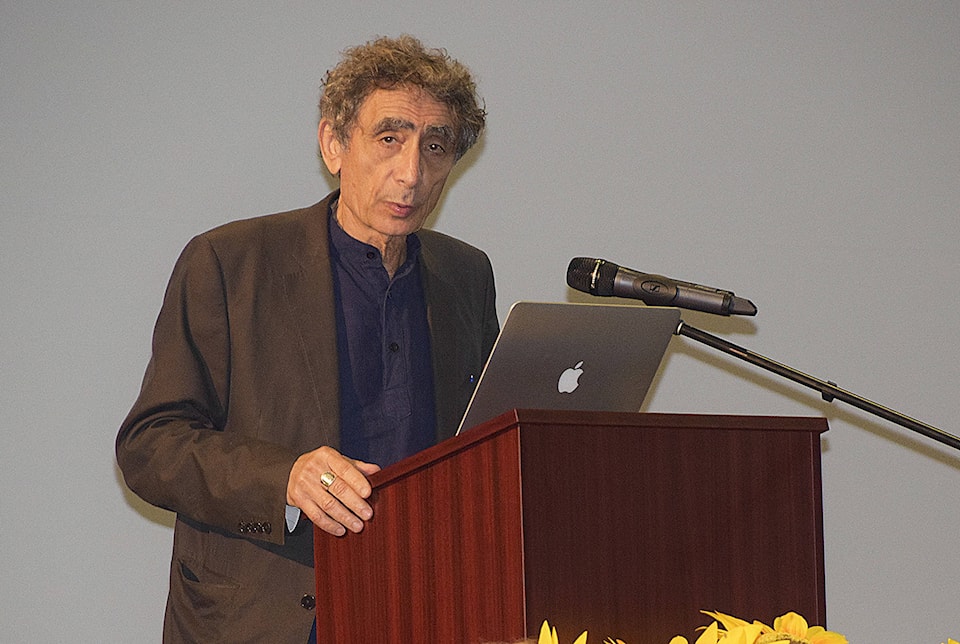Pretty much everything that���߲��о����s wrong with the world is wrong because of a lack of love.
With these words, Gabor Maté began a talk on addictions to close to 700 people in the Splatsin Community Centre.
As Maté - a physician, speaker, teacher and bestselling author - entered the large roundhouse-styled centre on June 1, everyone rose to their feet and singers greeted him with a welcome song.
The song centred around a traditional word of greeting that means ���߲��о����to wrap your arms around a visitor and protect them,���߲��о���� explains Splatsin elder Rosalind Williams, who was instrumental in Maté deviating from his original schedule and coming to the community. Maté told the gathering that he doesn���߲��о����t cry easily, but the welcome brought tears to his eyes.
This air of kindness and respect permeated his two-hour visit.
Mate´ talked about two common beliefs regarding addictions ���߲��о���� that they���߲��о����re a choice or they���߲��о����re a brain disease.
Regarding choice, he gave the example of a two-year-old who has a tantrum. The adult will punish them by giving them a time-out.
Maté noted that the same approach is used when people with addictions are sent to jail.
While the child is banished to their room, the adult is banished to prison.
���߲��о����It doesn���߲��о����t work with a two-year-old and it doesn���߲��о����t work with an adult,���߲��о���� he said.
He noted that if people didn���߲��о����t believe the two-year-old had a choice in the matter, they wouldn���߲��о����t be punishing them.
���߲��о����The belief is that drug addiction is a choice.���߲��о����
Regarding brain disease, Maté said a large portion of the medical profession seems to believe it���߲��о����s genetic, that people are born with it.
That���߲��о����s specifically what is believed about aboriginal people - that they are genetically predisposed to addiction, he said.
Maté pointed out there were no addictions in indigenous people until colonialism.
He spoke of all the ways that colonialism wrecked the traditional societies, and is still wrecking them.
He spoke about a woman in her 50s he met from the Sechelt Nation who was taken to residential school when she was four. The first day there she made ���߲��о����a very terrible mistake,���߲��о���� he said. She spoke her name in her own language. A pin was then stuck in her tongue and she had to hold her tongue out of her mouth for an hour.
That introduction was followed by years of sexual, physical and emotional abuse. By the age of nine, she was an alcoholic.
An addiction, Maté explained, is anything that a person craves, finds temporary relief from, suffers negative consequences from and can���߲��о����t give up. It could be anything, he said, from drugs to television.
The addiction, Maté emphasized, is not the problem, it is an attempt to solve the problem.
���߲��о����The problem was, reality was so difficult, they needed to escape from it.���߲��о����
He said counsellors, teachers and others should not ask first, why the addiction, but rather, why the pain?
Trauma gives you pain that you carry with you, Maté said. Then you develop shame about yourself.
If the world is not welcoming and parents are not loving and joyful, then a child believes himself worthless and is ashamed of who he is.
Later on, such a person might end up in relationships where they continue to get hurt, because they believe they deserve it.
Maté said there may be people in the room who have abused their children. First, he said, ���߲��о����I want you to forgive yourself,���߲��о���� words which led to tears for several present.
Equally important, he said, ���߲��о����I want you to understand where it came from.���߲��о����
He spoke at length about trauma, saying it is something that happens ���߲��о����inside you, you lose yourself.���߲��о����
He spoke of the value of First Nations traditions and how they connect people with themselves, with others and with the land ���߲��о���� traditions like drumming, singing, smudging, sweat lodges and meditation.
Maté said he had been in Vancouver���߲��о����s Downtown Eastside the day before his talk, where four people a week die from overdoses.
He said there���߲��о����s no fairness in the country-wide Fentanyl crisis.
���߲��о����As always, a disproportionate number of people who are suffering are First Nations.���߲��о����
He pointed out that First Nations make up only four per cent of the country���߲��о����s population, yet 30 per cent of the people in jail are First Nations.
In the prairie provinces, he said, only 10 to 15 per cent of the population is indigenous, but 80 to 90 per cent of children in foster care are First Nations.
���߲��о����There is no equality in suffering.���߲��о����
In welcoming Maté, Splatsin Chief Wayne Christian noted that Maté has done a lot of ���߲��о����amazing work���߲��о���� in the Downtown Eastside ���߲��о����helping our people.���߲��о����
The gathering closed with a traditional Bear Dance.
Following Maté���߲��о����s visit, Rosalind Williams explained that people expressed much appreciation for him, said he was very knowledgeable but down-to-earth, and they were still processing all his information.
Neskonlith Chief Judy Wilson said Maté validated her people and has given them hope with his practical and effective ways, and by pointing out how Western-based sciences are narrow and don���߲��о����t take a holistic approach to healing.



